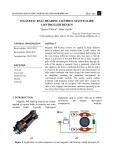
ISSN: 2615-9740
JOURNAL OF TECHNICAL EDUCATION SCIENCE
Ho Chi Minh City University of Technology and Education
Website: https://jte.edu.vn
Email: jte@hcmute.edu.vn
JTE, Volume 19, Issue 03, 2024
57
Leveraging Graph Neural Networks for Enhanced Prediction of Molecular
Solubility via Transfer Learning
Dat P. Nguyen*, Phuc T. Le
Ho Chi Minh City University of Technology and Education, Vietnam
*Corresponding author. Email: datnp@hcmute.edu.vn
ARTICLE INFO
ABSTRACT
Received:
22/04/2024
In this study, we explore the potential of graph neural networks (GNNs),
in combination with transfer learning, for the prediction of molecular
solubility, a crucial property in drug discovery and materials science. Our
approach begins with the development of a GNN-based model to predict
the dipole moment of molecules. The extracted dipole moment, alongside
a selected set of molecular descriptors, feeds into a subsequent predictive
model for water solubility. This two-step process leverages the inherent
correlations between molecular structure and its physical properties, thus
enhancing the accuracy and generalizability. Our data showed that GNN
models with attention mechanism and those utilize bond properties
outperformed other models. Especially, 3D GNN models such as ViSNet
exhibited outstanding performance, with an R2 value of 0.9980. For the
prediction of water solubility, the inclusion of dipole moments greatly
enhanced the predictive power of various machine learning models. Our
methodology demonstrates the effectiveness of GNNs in capturing
complex molecular features and the power of transfer learning in bridging
related predictive tasks, offering a novel approach for computational
predictions in chemistry.
Revised:
17/05/2024
Accepted:
20/05/2024
Published:
28/06/2024
KEYWORDS
Molecular property prediction;
Machine learning;
Deep learning;
Graph neural network;
Transfer learning.
Doi: https://doi.org/10.54644/jte.2024.1571
Copyright © JTE. This is an open access article distributed under the terms and conditions of the Creative Commons Attribution-NonCommercial 4.0
International License which permits unrestricted use, distribution, and reproduction in any medium for non-commercial purpose, provided the original work is
properly cited.
1. Introduction
Predicting molecular characteristics is crucial in computational chemistry, particularly in drug
discovery and materials research [1]. The effectiveness and viability of molecules in various applications
largely depend on properties such as solubility, lipophilicity, and reactivity [2]. Traditionally,
experimental methods have been the primary means for determining these properties. However, the
development of computational tools has substantially changed this process by providing faster and more
affordable alternatives. Precise estimation of these properties is vital in the early stages of drug
development, as it impacts the pharmacokinetics, pharmacodynamics, and overall feasibility of
medicinal substances [3]. Similarly, in the field of materials research, anticipating molecular properties
is essential for creating new materials with desired characteristics [4].
When computational methods were first developed, they primarily relied on quantum mechanical
techniques like density functional theory (DFT), which offered detailed insights into the electronic
structure of molecules. Although DFT and related methods have proved helpful in understanding the
characteristics of compounds, they are frequently computationally demanding and may not always be
practical for larger molecules or high-throughput screening [5]. This limitation led to the integration of
machine learning (ML) algorithms in computational chemistry, striking a balance between accuracy and
computational efficiency. ML models, particularly those based on molecular descriptors, have
successfully predicted numerous molecular properties. However, these models often require extensive
feature engineering and may not fully capture the complexity of molecular interactions [6].
Recent advancements have seen the emergence of graph neural networks (GNNs) as a powerful tool
in the field of molecular property prediction (Figure 1). GNNs capture the essence of molecular
structures more naturally by representing molecules as graphs [6]. This representation allows for a more

ISSN: 2615-9740
JOURNAL OF TECHNICAL EDUCATION SCIENCE
Ho Chi Minh City University of Technology and Education
Website: https://jte.edu.vn
Email: jte@hcmute.edu.vn
JTE, Volume 19, Issue 03, 2024
58
intuitive and detailed understanding of molecular interactions and properties [7]. GNNs have proven
their usefulness in drug discovery and pharmaceutical analysis by accurately predicting the activity or
effectiveness of medicinal compounds [8]. In addition, GNNs have shown remarkable performance in
predicting the outcomes of chemical reactions, such as the Buchwald-Hartwig and Suzuki-Miyaura
coupling reactions [9]. Beyond these specific applications, GNNs hold potential in areas such as organic
synthesis [10], molecular docking [11], and material science [12]. Overall, the adoption of GNNs in
these areas signifies a major shift towards more efficient, accurate, and predictive models in chemical
research and pharmaceutical development.
Figure 1. GNN Model for Molecular Property Prediction.
The main goal of our research is to predict the solubility of molecules by first constructing a
molecular dipole moment prediction model based on a GNN. Leveraging transfer learning, we then
apply this trained model to predict the water solubility of molecules. By utilizing the extracted dipole
moment features, along with other molecular descriptors, we aim to construct a more robust and accurate
predictive model for solubility. This two-step method represents a significant departure from
conventional approaches; it not only offers improved accuracy in molecular property prediction but also
serves as an exemplar of transfer learning applied to computational chemistry, potentially setting a new
precedent for future research in the field.
2. Computational Methods
2.1. Dataset Curation
The QM9 dataset, which was published by Ramakrishnan et al. in 2014 [13], offers a comprehensive
collection of quantum mechanical properties for a wide range of small organic compounds. This dataset
encompasses approximately 134,000 stable and synthetically accessible organic molecules along with
their properties, computed using high-level quantum chemistry methods. The dataset was downloaded
in comma-separated values (CSV) format from MoleculeNet [14]. For the construction of molecular
graphs for GNN models, the ‘SMILES’ column, which contains the SMILES (Simplified Molecular
Input Line-Entry System) representations of the compounds, were used. The ‘mu’ column, which
contains the dipole moment of molecules (in Debye), was utilized as the target for the GNN models.
The water solubility dataset (also known as the ESOL dataset), originally published by Delaney et
al. in 2004 [15], was obtained as a CSV file from MoleculeNet. This dataset is employed to predict
compound solubility based on molecular structure and chemical features. The ‘SMILES’ column was
utilized for feature extraction, while the ‘solubility’ column served as the target for our ML models.
2.2. GNN Models for Prediction of Dipole Moment
In constructing our GNN models, the first step involved transforming molecular structures into graph
representations, utilizing RDKit and DeepChem, two prominent open-source cheminformatics and deep
learning libraries. RDKit facilitates the conversion of SMILES notation into molecular structures, while
DeepChem’s graph featurizer is used to extract graphical data from these structures. Subsequently, the
dataset was divided into three subsets: training, validation, and testing, in a 60:20:20 ratio.
The molecular graphs generated from the training set were input into the GNN models (Figure 2).
These models were developed using PyTorch-Geometric, a leading open-source library for geographical
deep learning. The customized GNN models consist of 3 convolutional layers, each followed by a linear
layer with a rectified linear unit (ReLU) activation function. The outputs of these GNN layers were

ISSN: 2615-9740
JOURNAL OF TECHNICAL EDUCATION SCIENCE
Ho Chi Minh City University of Technology and Education
Website: https://jte.edu.vn
Email: jte@hcmute.edu.vn
JTE, Volume 19, Issue 03, 2024
59
further passed through a multilayer perceptron (MLP) predictor that consists of 3 linear layers with
ReLU activation function. During training, the models were periodically validated to monitor
performance and make necessary parameter adjustments. Various types of convolution layers were
employed in the GNN architecture, aiming to investigate different facets of graph-based learning and
feature extraction. The GNN models were trained for 100 epochs (except 3D models, which were trained
for 500 epochs) using a GeForce RTX 4090 with a specific set of training parameters for each model.
Figure 2. Structure of GNN Model.
After training, the test dataset was employed to assess the model’s predictive performance.
Regression metrics, including mean absolute error (MAE), root mean square error (RMSE) and the
coefficient of determination R2, were used for this evaluation.
Here, 𝑦𝑖 represents the predicted values, 𝑦𝑖 the observed values, 𝑛 is the number of observations, and
𝑦𝑖 is the mean of observed values.
2.3. ML Models for Prediction of Water Solubility
In the development of our water solubility prediction model, the process began with extracting a
comprehensive list of molecular features using RDKit from the SMILES representations of the
molecules. These features include molecular weight, number of rings, ratio of sp3-hybridized carbon,
number of hydrogen bond donors and acceptors. The extracted features were then combined with the
dipole moments produced by the best-performing GNN model, creating a rich dataset for solubility
prediction. Subsequently, the dataset was divided into two primary parts: training and testing, following
an 80:20 ratio. In cases where model validation during training was required, a three-part split
comprising training, validation, and testing was employed, following a 60:20:20 ratio.
The training set was used to train various machine learning (ML) models selected from well-
established libraries such as Scikit-learn and PyTorch, each offering a range of algorithms suitable for
regression tasks. Prior to training, the features were scaled using normalization to ensure that the
transformed values were comparable and to prevent the dominance of features with larger scales. The
training of ML models was conducted on a local computer with a selected set of parameters. Deep
learning models were trained for 100 epochs using a GeForce RTX 4090.
Upon completion of the training phase, the test dataset was used for model evaluation. Similar to the
GNN models, the effectiveness of each model was assessed using a range of metrics, including MAE,
RMSE and R2.

ISSN: 2615-9740
JOURNAL OF TECHNICAL EDUCATION SCIENCE
Ho Chi Minh City University of Technology and Education
Website: https://jte.edu.vn
Email: jte@hcmute.edu.vn
JTE, Volume 19, Issue 03, 2024
60
3. Results and Discussion
3.1. Evaluation of GNN Models for Prediction of Dipole Moment
In assessing the performance of our GNN models, a pivotal factor considered was the structure of
the convolutional layers. Models with and without an attention mechanism, as well as those incorporate
or exclude bond attributes, were examined (Table 1). The attention mechanism in GNNs is designed to
selectively weigh the significance of nodes during the feature aggregation process.
Table 1. Evaluation of Convolutional Layers for Prediction of Dipole Moment.
Entry
Convolutional
layer
Attention
Bond
attributes
MAE
RMSE
R2
Ref.
1
GCNConv
No
No
0.6332
0.9156
0.6478
[16]
2
SAGEConv
No
No
0.5736
0.8502
0.6963
[17]
3
SGConv
No
No
0.6350
0.9232
0.6419
[18]
4
ClusterGCNConv
No
No
0.5764
0.8372
0.7055
[19]
5
GraphConv
No
No
0.5904
0.8648
0.6857
[20]
6
LEConv
No
No
0.5903
0.8571
0.6913
[21]
7
EGConv
No
No
0.5214
0.7913
0.7369
[22]
8
MFConv
No
No
0.5373
0.7987
0.7319
[23]
9
TAGConv
No
No
0.6005
0.8699
0.6820
[24]
10
ARMAConv
No
No
0.5179
0.8102
0.7242
[25]
11
FilMConv
No
No
0.5347
0.8159
0.7203
[26]
12
PDNConv
No
Yes
0.5536
0.8281
0.7119
[27]
13
GENConv
No
Yes
0.5056
0.7865
0.7400
[28]
14
ResGatedGraphConv
No
Yes
0.4847
0.7516
0.7626
[29]
15
GATConv
Yes
Yes
0.5315
0.7963
0.7336
[30]
16
GATv2Conv
Yes
Yes
0.5062
0.7695
0.7512
[31]
17
TransformerConv
Yes
Yes
0.5169
0.7949
0.7345
[32]
18
SuperGATConv
Yes
Yes
0.5194
0.7876
0.7393
[33]
19
GeneralConv
Yes
Yes
0.4803
0.7503
0.7635
[34]
Convolutional layers such as GCNConv, SAGEConv, and SGConv, which do not utilize attention
mechanisms or bond attributes, exhibited moderate degrees of performance (Entries 1–11). Specifically,
SGConv showed the highest RMSE value of 0.9232, indicating less accurate predictions (Entry 3).
Conversely, EGConv demonstrated the best performance among this group, with an R2 value of 0.7369
(Entry 7).
When comparing the impact of incorporating bond attributes into the model, we observed a notable
improvement in predictive accuracy (Entries 12–14). Models utilizing bond attributes yielded an average
R2 of 0.7421, in contrast to their counterparts that ignored these attributes, which exhibited an average
R2 of 0.6967 (Figure 3a). This improvement underscores the significance of bond information in

ISSN: 2615-9740
JOURNAL OF TECHNICAL EDUCATION SCIENCE
Ho Chi Minh City University of Technology and Education
Website: https://jte.edu.vn
Email: jte@hcmute.edu.vn
JTE, Volume 19, Issue 03, 2024
61
capturing the nuances of molecular interactions essential for the accurate prediction of properties such
as solubility. Convolutional layers like PDNConv (Entry 12) and GENConv (Entry 13) demonstrated
better predictive accuracy. Notably, ResGatedGraphConv emerged as the most accurate, with the lowest
MAE of 0.4847 and the highest R2 of 0.7626 (Entry 14), indicating the benefits of including bond
attributes.
Figure 3. R2 Values of GNN Models for Prediction of Dipole Moment.
Further results indicated that models with attention mechanisms (Entries 15–19) surpassed those
without, evidenced by a lower MAE of 0.51084 compared to 0.56106 and an average R2 of 0.7444
versus 0.7056 (Figure 3b). The enhanced performance suggests that attention mechanisms enable
models to focus on more relevant features for predicting the dipole moment, crucial for accurate
solubility predictions. This is exemplified by the improved outcomes of GATConv and GATv2Conv,
both employing attention and bond attributes, with R2 values of 0.7336 and 0.7512, respectively (Entries
15–16). Remarkably, GeneralConv, integrating both features, achieved the best overall result with an R2
of 0.7635 (Entry 19), highlighting the combined benefits of attention mechanisms and bond attributes.
In summary, GNN models enhanced with attention mechanisms and bond attributes consistently
outshone those without. The data supports the assertion that these features are substantial contributors
to model accuracy, signifying their crucial role in designing GNNs for molecular property prediction.
Such advancements in model precision indicate a promising future for computational chemistry, offering
scientists more reliable and sophisticated tools for their research.
We next evaluated the outputs of 3D GNN models, which consider the spatial arrangement of atoms
and thus offer a more detailed depiction of molecular structures. The results demonstrated that 3D GNNs
substantially outperform other GNN models in predicting the dipole moment, as shown in Figure 4.
SchNet [35], with an RMSE of 0.0052 and an R2 of 0.9899, effectively captures the electronic
environments of molecules through 3D convolution. DimeNet++ [36] shows further enhancement, with
an RMSE of 0.0041 and an R2 of 0.9937. The most impressive performance is from ViSNet [37], which
achieves an exceptional RMSE of 0.0023 and an R2 of 0.9980, underscoring the benefits of leveraging
3D spatial data.
Compared to standard GNN models that overlook spatial information, the advancements with 3D
GNNs are noteworthy. These models transcend the limitations of simple structural and bonding details
by effectively integrating the molecular geometry and orientations, which are critical for accurately
predicting inherently three-dimensional properties such as the dipole moment. These findings suggest
that for challenges demanding a nuanced comprehension of molecular geometry, 3D GNNs are not only
more suitable but also significantly more precise in their predictions.












![Đề cương đề tài nghiên cứu khoa học [chuẩn nhất/mới nhất]](https://cdn.tailieu.vn/images/document/thumbnail/2025/20251117/duong297/135x160/26111763433948.jpg)













